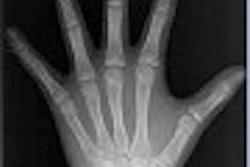In a developing country where millions live below the poverty line, x-ray remains the basic diagnostic tool for detecting medical conditions, anomalies, and disease. The modality is especially critical for children who are too young, unwilling, or unable to communicate the source of their discomfort. Detecting the malady is often left to the keen eyes of the radiologist, with direction from the clinician.
The Institute of Child Health and Children's Hospital in Chennai, the acclaimed medical capital of India, treats well over 2,000 children a day as outpatients, as well as about 520 admitted patients. Like other hospitals in Tamil Nadu, the institute gives absolutely free treatment, and the hundreds of x-rays exposed daily provide the fulcrum for monitoring the clinical condition of child patients.
Recently a 4-year-old child was admitted in the casualty ward with acute abdominal pain. All of the symptoms were indicative of appendicitis. Even as the boy was wheeled to an operating theatre that was being prepared for an emergency operation, an x-ray of the abdominal region was quickly taken. As surgeons awaited the confirmation, a monitoring team of radiologists under Dr. Ramalingam was able to rule out an appendectomy. Based on the x-ray, the group's finding was a clear case of lead poisoning.
The x-ray helped avoid an unnecessary surgical procedure, and also pinpointed the cause of the symptoms, which to the physician seemed clearly similar to appendicitis. With the radiologist's report, the child was moved to the clinical ward for treatment.
According to statistics based on last year's figures, 2,239 children on average were treated each day at the hospital. In an interview with AuntMinnieIndia, Ramalingam confirmed that about 10% of the infants brought to the hospital's outpatient department require x-ray screening. Of the 250 x-rays taken daily, very few have to be further investigated with MRI or ultrasound, according to Ramalingam.
So at least for another decade, x-rays will continue to be the mainstay for examination of child patients. When outbreaks of infection or near epidemic conditions are prevalent, the number of patients is likely to swell with the average increasing to 2,300 outpatients a day.
X-ray examinations constitute roughly 10% of the cases, which is the industry average according to official sources. Dr Seena, consultant radiologist at the Indian Diagnostic Centre in Chennai, confirmed this and stated that even at private hospitals this would be the average. "Radiologists work behind the scene and are rarely seen or heard, except through their reports," she added.
But as always, the winds of change must blow sooner or later through the systems currently in vogue. Giving a fresh perspective to the economics of providing free medical care at government hospitals, Dr I. Kandasamy, while acknowledging the predominant role of x-ray, believes that a one-time investment in new technology such as digital x-ray equipment could save hospitals and the government the significant recurring expense of x-ray film. Kandasamy is the immediate past president of the Indian Radiologists Association.
"Recalling data is presently a gigantic task, involving wading through thousands of x-rays," he said. "Large areas of floor space are taken up in storage of x-rays, and this can be freed for outpatients or intensive care units. Finally, x-rays deteriorate in quality over time, especially in tropical regions and humid climates."
The capital cost of an investment in digital x-ray equipment is around Rs. 25,00,000, but the cost can be recovered in several years, even for hospitals requiring only a hundred x-ray plates daily. "Even smaller private hospitals have switched to digital x-rays," Kandasamy said.
"We should also not ignore the other diagnostic tools like ultrasound and MRI," he added. "We should rethink the investigative modalities used in diagnosis. There is a shortage of qualified CT technicians, but just two to three seniors using broadband and teleradiology can reach out to the rural populace."
"Tamil Nadu is presently networked by hospitals every 100 kms, but use of such modern technology can facilitate widespread use, and it is high time this was brought to the notice of the government," he said.
By Ravi Damodaran
AuntMinnieIndia.com contributing writer
December 28, 2004
Copyright © 2004 AuntMinnie.com



















